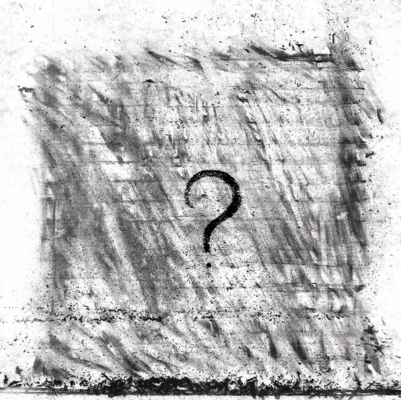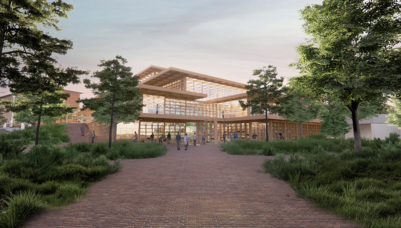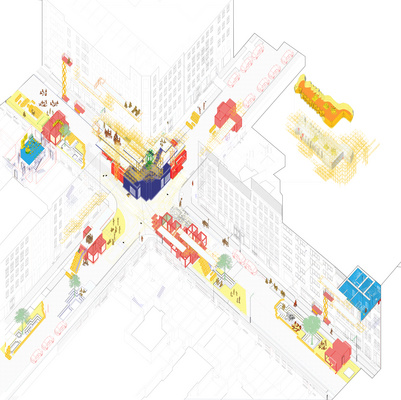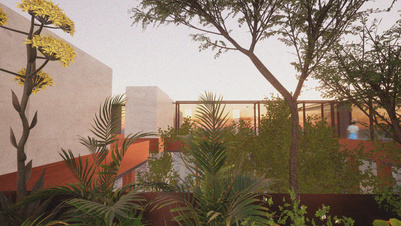ABOUT
The project deals with the problem of declining civic engagement in Russian society by exploration of Russian residential socio-spatial landscapes. The project hypothesizes that by addressing challenges at the micro level, it is possible to positively impact macro level outcomes by shaping the attitudes and beliefs of individuals through changes in their personal experiences and social networks.
The Pattern of Erasure
Over the last century multiple major societal shifts have influenced the state of Russian society and had noticeable impacts on civic engagement at both national and local scales. As a result, the current weak state of civic engagement intensifies social exclusion of certain groups from a dominant national narrative and can be seen as a major aspect of the democracy crisis.
With almost 80% of Russian population living in microrayons, Russian residential landscape is generally characterised by mass-produced panel housing. Thus, microrayons, as a small community within a city, can be seen as a miniature representation of Russian society as a whole.
The project hypothesizes that by addressing challenges at the micro level, it is possible to positively impact macro level outcomes by shaping the attitudes and beliefs of individuals through changes in their personal experiences and social networks.
This project develops an urban strategy which is rooted in a theory “The Strength of Weak Ties“ by Mark S. Granovetter. By emphasizing the value of loosely defined structures and connections, both social and spatial, the project aims to uncover potentials for reinforcement of weak ties which could positively impact both micro and macro civic climate.
Moscow Periphery
The project lands itself in Moscow Periphery due to its landscape being characterised by Soviet panel housing forming microrayons which serve as a connecting tissue of Moscow urban fabric. Overall, almost 80% of Moscow's housing consists of mid and late Soviet panel housing.
Yasenevo Microrayon
Yasenevo is a residential district located in the South-Western part of Moscow, Russia. It covers an area of 25.4 square kilometers and has a population of approximately 172,300 residents. The district was developed in the 1970s under the guidance of architect Yakov Belopolsky, with the aim of creating a residential area without major industrial sites.
Similarly to other Moscow microrayons, Yasenevo exhibits a complex socio-spatial layering which starts with its pre-soviet state when it was a fairly large village. The first point of spatial erasure in the context of Yasenevo happened with its construction which replaced the village almost entirely. The new spatial conditions were aimed on providing housing for 170,000 people. These new conditions formed an entirely new spatial character of the area. Yet, the natural landscape was integrated in Yasenevo design, as a result it is embedded in greenery with multiple large forests which surround the site. At the same time, large spaces in between the buildings generate a layer of trails and paths.





The Sleeping District
The focus of the project is on the current problem of sleeping civic society, which was identified in my written assignment last semester. It was noticed from conducted interviews that current residents showcase a lower engagement in spatial practices than the first generation of residents who moved in shortly after construction. Like this, first residents of microrayon were engaged in yards upkeeping, planting trees, building playgrounds. Current trend shows a general satisfaction with a state-led development and low residents engagement.


Existing Social Captial
The project vision is rooted in the existing social capital of the microrayon. People tend to romanticise these spaces and due to their universal similarity it is easy to relate to this atmospheric character. This practice can be seen as an emotional appropriation of microrayon and as a stepping stone to establishing a strong identity. But can this practce be taken one step further?
Russian sociocultural phenomenon named ZHKKH-ART (housing and utilities art) is an example of informal claiming of spaces and objects in microrayons. A practice which emerges from social and spatial frictions of residential landscapes. This phenomenon floats between a form of creative act and a form of social activism. The project aims to see public space beyond its spatial constraints and understand spaces as civic enablers where spatial and social friction act as a catalyst of engagement.

Wilderness as a Civic Stage
The project aims to see wilderness as a socio-spatial stage which has a capacity to formulate unretrictive democratic landscape. A German film Natura Urbana: The Brachen of Berlin suggests that these exotic landscapes provide a form of re-discovery of the place within a strictly organised environment of the city.
Yasenevo has a strong presence of nature in its landscape. It is bounded by three large forests to the North, East and South with numerous small forests within the yards. As a result, nature serves as a spatial tissue. At the same time, nature also has a function of a social tissue. As seen from the interviews residents have a close connection to the forests around the site.
The project develops a framework to curate the wilderness and use is as a tool to amplify existing landmarks of the area. This new spatial network can act as a stage for engagement in spatial practices where existing landmarks will act as social anchor points.




Toolkit for Civic Engagement
The project develops a document guide for the residents of microrayon - "Toolkit for civic engagement". A step-by-step guide which suggests a number of spatial interventions and steps for their implementation. The document should only be viewed as a design suggestions, since real objects of civic interactions can only emerge from the residents and actors on site.
Major and minor landmarks are chosen for the development of functional interventions which form the basis of toolkit. Each intervention is designed to amplify the existing qualities of the landmark it ocupies and at the same time provide civic functions for reinforcement of the weak ties between the residents of microrayon.














































